With Pirate Movies we have seen a come back of those old Telescopes that navigators used for centuries before the GPS was publicly available.
Although often referenced as Pirate Telescope, those were regular captain navigation telescopes and pirates happened to steal them along other treasures. Not like pirates invented them…
Many of these telescopes are just for decoration. Some are functional, though, meaning that it is mounted with actual lenses. I’ll talk about a few functional ones here, because I think. All such telescopes are Refractors.
I think these Brass Telescopes are a great gift to people who like navigating the seas and astronomers alike. After all, astronomy started to increase quickly at the time people started to get such telescopes (around Galileo’s time).
Remember, though, that navigation telescopes have never been as powerful as astronomy telescopes. One reason was that these were easier to build since they did not require high quality lenses and tubes as astronomy telescopes.
How Do These Telescope Work?
Contrary to an astronomical telescope, the navigation telescopes are retractable. This means the focal distance is likely going to be somewhat messed up.
The focus, a.k.a. whether you see a blurry image or not, depends on the correct distance between the two lenses. The one on the far side and the one by your eye. Most retractable telescopes only work when fully opened to their full distance. If it has an imperfections, though, it is likely going to always be somewhat off. A professional telescope includes a precision lens by your eye piece so you can adjust the distance as required and make the image crisp.
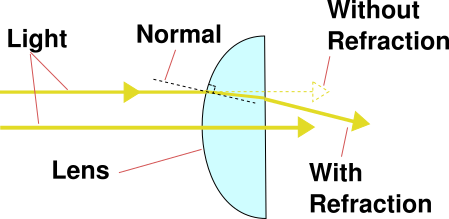
Figure 1. shows incoming straight rays of light. When light hits a lens (or any material, really), refraction occurs because photons travel slower in glass (nearly 1/3rd) than in the air. Refraction means that the light takes a turn if the surface is bent. The amount of bending (how sharp the turn is) depends on the material (i.e. water, glass, diamond, transparent concrete…) and on the curvature at the time of impact. If there is no curvature at the point of impact, then no bending occurs and the photons go straight through (shown on Figure 1. with the line of light shown in the middle.)
My diagram also shows a dashed line crossing the glass at a straight angle. This is to show the difference between light that gets refracted and light that does not.
When photons exit that lens, they bend away from the normal (the line that crosses the tangent at a right angle) since they accelerate again (glass to air, slow to fast).
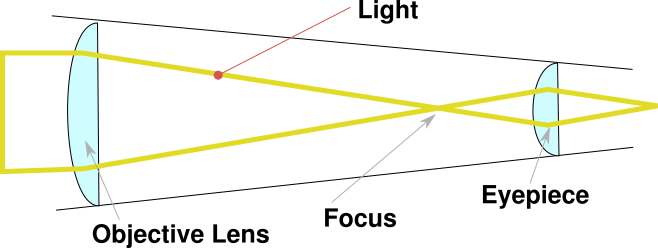
The result is a concentration of light at one point behind the lens. That point is called the focal point (some people also call it the focus point, hence that term in Figure 2.) From that point on, the photons separate from each others again.
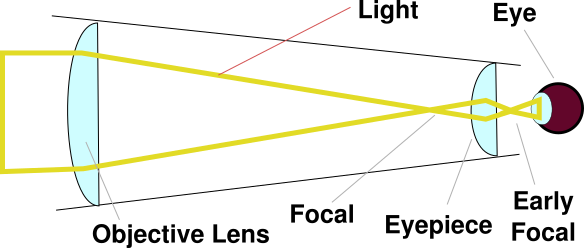
If you’ve seen that before, the focal point is the point we can use to start a fire. It tends to get really hot since there are so many photons concentrated in a single point.
In Figure 3. I show how the focal point can end up at the wrong place and as a result your eye sees a blurred image. Unfortunately, some retractable telescopes will either not extend enough or extend too much. Too much, you may be able to help it by adjusting the length. Too little and you’re at a loss… the focus just can’t be reached. If you purchase such a telescope from a store, make sure to check it out before you get out.
Choosing a Navigation Telescope
Small Toy or For Display
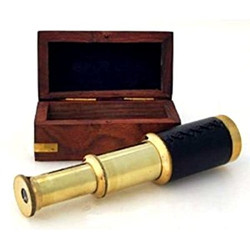
There are quite a few you can find on Amazon. Here is a small one that is probably more for display or a child who likes pirate. It has a magnification of about ×3.
Note that there are plastic toys for the same price and worst quality. This is a really cool toy for a child learning how a telescope works.
The magnification is minimal at ×3 so you won’t see a huge difference. For proper focus, you must keep the telescope fully expanded. There is no fine adjustments on this telescope so if the focus can’t be attained when the scope is fully extended, or close to that, then you got the wrong one… For the price, though, it’s not going to be a big surprise.
The box is quite plain, which for a child is still going to be really nice. He can put sticker and draw on it. Once retracted, the telescope fits just fine in the box.
Many kids, who like playing pirate, have had a lot of fun with this mini-telescope!
A ×25 Monocle—SGODDE Collapsible Captain’s Brass Spyglass
The Sgodde Collapsible telescope is much more serious and will easily break if it falls on the ground, so it not for kids who still have a hard time handling fragile objects. You know your kids, so you’re the judge. My daughter could have handled it at 8, but my boys, probably more like 10 or 11.
Like most such telescopes, I think these are more for decoration, but this one does work and is quite practical. It extends to about 33 centimeters (13 inches) giving the telescope a pretty good aperture with a resulting magnification of about ×25 which gives you a field of view of about 1,000 meters.
It can be used to watch stars at night, which is the way navigation would be done when the sun disappeared. The magnification is better than many binoculars, so don’t feel bad.
It can also be used to check out animals in mountains, swamps, prairies… Since it’s a monocle, everything you look at with it will look like it’s 2D. You need both eyes to see in 3D. That being said, it’s still wonderful to watch wild animals.
With a ×25, you’re going to be good. Compared to my binoculars that I got as a child were only ×10 and I was able to see quite a bit already. I watched wild goats, chamois, ground hogs… So with this piece of equipment you will be able to observe quite a bit of wild life. And it retracts to a very small size so it can easily be carried.
Along the Binocular You Need a Sundial Compass
If you want to use your Binocular to navigate the seas at night, you also need a compass and during the day, you want a sundial.
Now, watch out, you’ll need to learn how to read a sundial. I have no idea how you do that, so I wish you good luck. I’m sure you’ll find other websites to help you on that one.
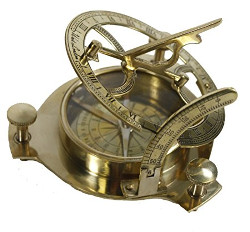
I found a couple that look great and are fully functional. This small one is just 4″. Made out of brass. You can move the dial as required to measure your position from the sun and there is compass inside to orient the dial first.
Although it does not come with a box, you do have three screws to install the compass on your boat floor. Just kidding, you probably don’t want to do that. But you can have your own box and attach it there.
Now if you are in steampunk type of things, there is an even better with a nice box and an incredible sundial and compass.
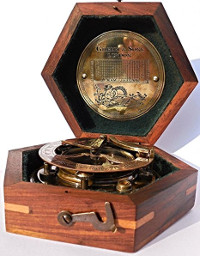
This one is already in a box with a really nice hook. The finish is just exceptional. The inside of the cover has a chart that gives you the position of the sun depending on the date.
The name Gilbert & Sons, London is engraved on various parts, making this item look like it is just the real thing.
Oh, actually it says it was built in 1895. It’s obviously all new materials, but it really looks old. Like a real important museum collection item.

Leave a Reply